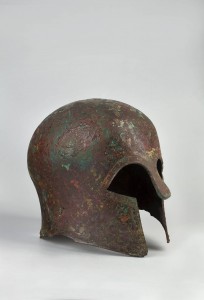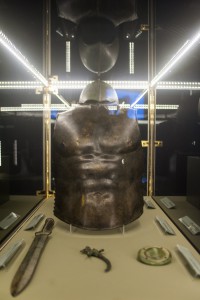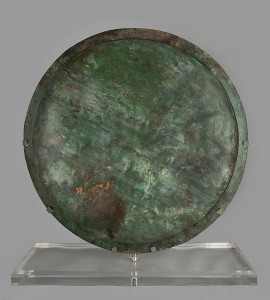The National Museum in Warsaw
 Owing to the hospitality of the National Museum in Warsaw, and especially to our collaboration with Dr. Alfred Twardecki – the Museum’s Curator in Chief of the Collection of Ancient and East Christian Art – we will visit the exhibition Hoplites. On the Art of War of Ancient Greece. The exhibition features an animation entitled Hoplites! Greeks at War prepared by our team members – Dr. Sonya Nevin and Steve Simons from Panoply who will present the plans for our further collaboration with the Museum within the project Our Mythical Childhood… The Reception of Classical Antiquity in Children’s and Young Adults’ Culture in Response to Regional and Global Challenges supported by the ERC Consolidator Grant awarded to Prof. Katarzyna Marciniak. We hope that it would be possible for Dr. Sonya Nevin and Steve Simons to prepare a series of vase animations from the Museum’s fabulous collection, waking mythical heroes and creatures to life and inspiring contemporary art and education. Moreover, during our visit in the Museum Dr. Twardecki will present the vision of a new Ancient Art Gallery to be opened in 2019.
Owing to the hospitality of the National Museum in Warsaw, and especially to our collaboration with Dr. Alfred Twardecki – the Museum’s Curator in Chief of the Collection of Ancient and East Christian Art – we will visit the exhibition Hoplites. On the Art of War of Ancient Greece. The exhibition features an animation entitled Hoplites! Greeks at War prepared by our team members – Dr. Sonya Nevin and Steve Simons from Panoply who will present the plans for our further collaboration with the Museum within the project Our Mythical Childhood… The Reception of Classical Antiquity in Children’s and Young Adults’ Culture in Response to Regional and Global Challenges supported by the ERC Consolidator Grant awarded to Prof. Katarzyna Marciniak. We hope that it would be possible for Dr. Sonya Nevin and Steve Simons to prepare a series of vase animations from the Museum’s fabulous collection, waking mythical heroes and creatures to life and inspiring contemporary art and education. Moreover, during our visit in the Museum Dr. Twardecki will present the vision of a new Ancient Art Gallery to be opened in 2019.
Below you will find a description of the Hoplites exhibition.
For more information on the Panoply animation see here.
Hoplites. On the Art of War of Ancient Greece
(1 July 2015–30 September 2016)
Anticipating the near opening of the Ancient Art Gallery, the presentation brings together ancient weapons and armor (mainly Greek) from the collections of the National Museum in Warsaw and precious items from the old collection of Axel Guttmann, a long term deposit made to the Museum by his son Alexander.

At the heart of this display as a unique Late Geometric helmet from the age of Homer and the only shield in Poland to date from the turn of the 6th century, that is, from the youth of King Leonidas of Sparta, commander of the 300 Spartans who laid down their lives at Thermopylae (480 BC). The presentation is accompanied by recitations of battle elegies by the Greek poet Tyrtaios that were highly popular in Sparta of the 6th and 5th century BC. Greek civilization owed its success to a developed art of warfare that ensured them superiority over much larger armies. The victories at Marathon and Plataea were achieved foremost by the hoplites, the heavy-armored infantry fighting in a formation called the phalanx.

Their battle successes laid the cornerstone for the topos of European civilization being capable of defeating stronger enemies thanks to the moral virtues of its units and a better organization. The hoplites repeatedly defended the Greek poleis throughout the Mediterranean world and in the Black Sea littoral, standing in their protection against native tribes like the Gauls, Libyans, Italics and Scythians, but also against the mighty empires of their times — Persia and Carthage. The cavalry and light infantry were auxiliaries in the warfare of Archaic and Classical Greece, assisting the core formation in battle, which was the heavy-armored hoplite formation. The unquestioned supremacy of Greek weaponry and tactics in this period is attested also by the value of Greek mercenaries; indeed, thousands of Greek soldiers served in other armies on many occasions. Best fit to cite here the testimony of Xenophon, who describes in his Anabasis the march of ten thousand Greeks across almost the entire Persian empire.

The earliest information about hoplites date to the turn of the 8th century BC, roughly speaking the age of Homer. The Iphicratean reforms of the early 4th century BC put an end to the formation. Between the 7th and 4th centuries, the hoplite phalanx in battle was always decisive. There was no other formation at that time capable to withstand the wall of bronze shields and spears. The phalanx was a formation several rows deep with the front line of warriors with shields forming a wall. Each man shielded himself and partly his neighbor in line. This formation was very difficult to break up in frontal attack, especially for lighter units. Spears were used for offensive warfare, keeping the enemy at a distance. Once the spears were gone, swords were the weapons of last chance. The phalanx usually attacked by approaching the enemy steadily, but at the Battle of Marathon (490 BC) the last few dozen meters the Greeks covered at a run.
For more information visit the Museum’s website.
P.S. Some mythological creatures might be seen at the newest exceptional exhibition, The “Anything Goes” Museum (28 February–8 May 2016), curated by children – a museological and educational experiment – coined by the Director of the National Museum in Warsaw, Dr. Agnieszka Morawińska. See, e.g., Dance of the Minotaur.